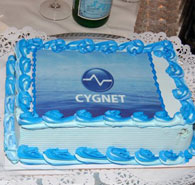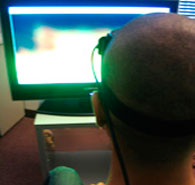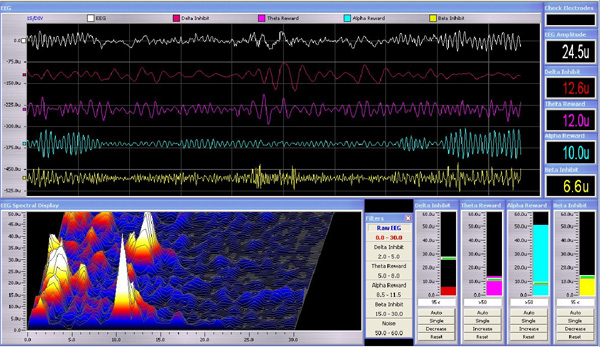Archive for the ‘Software Related’ Category
Tuesday, April 22nd, 2008
 It’s been a few months, and it’s been a total whirlwind here at EEG Info so let me try to remember all the way back to November for a moment. It seems like a year ago now, but that was about the time when all of us here at EEG Info held our breath as we put Cygnet out to you, our Neurofeedback community. We ordered 100 extra NeuroAmps, on top of our regular inventory, just to prepare for the rush that we hoped to get. We knew we had created something that fit our training model, that was easy to use, beautiful to look at, and functionally the most advanced design we have ever built. But what about you — the customer? Would you find it as intuitive, useful and appealing as we designed it to be? Would anyone actually appreciate all this hard work and huge amounts of money and energy and risk that went into the creation of this product? (more…) It’s been a few months, and it’s been a total whirlwind here at EEG Info so let me try to remember all the way back to November for a moment. It seems like a year ago now, but that was about the time when all of us here at EEG Info held our breath as we put Cygnet out to you, our Neurofeedback community. We ordered 100 extra NeuroAmps, on top of our regular inventory, just to prepare for the rush that we hoped to get. We knew we had created something that fit our training model, that was easy to use, beautiful to look at, and functionally the most advanced design we have ever built. But what about you — the customer? Would you find it as intuitive, useful and appealing as we designed it to be? Would anyone actually appreciate all this hard work and huge amounts of money and energy and risk that went into the creation of this product? (more…)
Posted in Commentary, Software Related | No Comments »
Thursday, March 1st, 2007
 The new pIR3 is a passive infrared sensor device for biofeedback. Three infrared sensors are mounted in the plastic housing that sits on the forehead and is attached with an adjustable band around the head. Since we are looking at signals from left, right and center, it is important to place the device appropriately so that the label is right side up and the cable extends from the right side of the device. The infrared sensors are not in contact with the forehead, but are held at some distance away so they can measure heat that is radiated from the head. It is important to seat the housing securely (stably) just above the eyebrows. If any hair falls between the forehead and sensors, the signal will be diminished and also more variable, so care must be taken to move any hair out of the way. The new pIR3 is a passive infrared sensor device for biofeedback. Three infrared sensors are mounted in the plastic housing that sits on the forehead and is attached with an adjustable band around the head. Since we are looking at signals from left, right and center, it is important to place the device appropriately so that the label is right side up and the cable extends from the right side of the device. The infrared sensors are not in contact with the forehead, but are held at some distance away so they can measure heat that is radiated from the head. It is important to seat the housing securely (stably) just above the eyebrows. If any hair falls between the forehead and sensors, the signal will be diminished and also more variable, so care must be taken to move any hair out of the way.
The pIR3 follows the lead of Jeff Carmen, who has worked extensively with pIR HEG biofeedback, primarily for migraine headaches. Jeff’s work has used a single sensor for feedback, which is typically placed at Fpz. The pIR3 provides three sensors at approximately Fp1, Fpz and Fp2, and hence the ability to combine the signals as desired for feedback purposes. The pIR3 plugs into any of the three peripheral device inputs on the front of the Neuroamp. BioExplorer software displays the signals and Particle Editor provides additional feedback information and reward. (more…)
Posted in Biofeedback, Hardware Related, PIR / NIR, Research, Software Related | 1 Comment »
Thursday, January 4th, 2007
 Updated BioExplorer designs are available at http://www.neuroamp.com/. The tactile feedback is now more responsive and gives better feedback on the amplitude of the reward band. I find that most clients are now willing to hold, or sit next to, Neury the Bear. There are, of course, a few people who are too sensitive to tolerate the vibration or too embarrassed to hold a Teddy bear. Updated BioExplorer designs are available at http://www.neuroamp.com/. The tactile feedback is now more responsive and gives better feedback on the amplitude of the reward band. I find that most clients are now willing to hold, or sit next to, Neury the Bear. There are, of course, a few people who are too sensitive to tolerate the vibration or too embarrassed to hold a Teddy bear.
The new Alpha-Theta designs provide tactile feedback that switches between alpha and theta depending on which is dominant relative to the goals. When you are in alpha and listening to the stream, the tactile feedback reflects alpha amplitude. And when you are in theta and listening to the surf sounds, the tactile feedback reflects theta amplitude. Tactile feedback is a particularly good addition to the auditory feedback in Alpha-Theta. The information flows directly into the body without any conscious attention.
If you have created a separate folder for the designs you use regularly, then you will need to copy over the new designs from the EEGInfo Designs folder.
Posted in Hardware Related, Software Related | No Comments »
Thursday, October 5th, 2006
**Bioexplorer Deep-State Designs and Alpha-Theta Sounder is No Longer Available – This is an archived post from 2006
We are releasing a new Alpha-Theta program and three new deep-state designs for BioExplorer. Similar settings files are already available on BrainMaster for use with the EEG Audio program. The Alpha-Theta Sounder program provides audio feedback reflecting alpha and theta amplitudes and the shifting of deep states. The new BioExplorer designs allow one-channel Alpha-Theta with two different displays for the clinician, plus two-channel sum training.
EEGInfo 1 Channel Alpha-Theta
 (more…) (more…)
Posted in Software Related | 4 Comments »
Wednesday, May 24th, 2006
We have recently shifted from wide inhibits to multiple inhibits in our clinic. This is useful in more clearly separating our understanding and implementation of rewards and inhibits. It also moves us along in shifting the burden of managing inhibits to the software and letting the clinician focus on adjusting reward frequency.
The wide inhibits (2-13 and 14-30 Hz) have effectively covered the entire range of 0-30+ Hz. High amplitude activity, meaning a transient increase in amplitude at any frequency, is detected and inhibited. We have for some while found the wide inhibits to be more clinically effective than narrower inhibit bands in most cases. And separate thresholds on the lower and higher frequency bands allow more effective feedback since amplitudes can be very different at high and low frequencies. Multiple inhibits now take us further in that direction, allowing the inhibit thresholds to fit the spectral like a glove rather than a mitten. (more…)
Posted in Software Related | No Comments »
Wednesday, April 26th, 2006
While I have appreciated the power and flexibility of BioExplorer, I also realized that we needed to increase its user-friendliness for general clinical use. I have been working on designs that are easy to look at and understand and require minimal adjustments within a session. This first set of designs implements our basic one-channel training with high and low inhibits and adjustable reward band.

The raw EEG and filtered bands are displayed as usual. The raw EEG is displayed with a 0-30 Hz filter, which gives a nice clean trace. The raw EEG filter affects only the oscilloscope display — not the signal that is passed on to the other filters or spectral display, so the high frequency activity is still available if needed. I have chosen a fixed scale for the raw EEG so that different EEGs can be meaningfully compared. Any BioExplorer variable can, of course, be changed as needed, but I am trying to minimize the need for such adjustments within and between sessions. The filtered traces auto-scale so they fit consistently on the screen. Threshold elements are available for changing auto-goal criteria, but auto-scaling bar graphs are also shown. This allows us to see how the signals relate to the thresholds without constantly re-scaling the threshold displays. The compressed spectral array shows about 12 seconds of EEG data, which can be related to the raw signals above. The filter element easily allows shifts in reward frequency (or inhibits) during the session. Filters are carefully selected to optimize the clinical efficacy. The design also supports tactile feedback and poor electrode contact detection when using the Neuroamp. Neury’s amplifier plugs directly into the Neuroamp. The tactile output is very smooth and adds significantly to the power of the feedback. The “Check Electrodes” box turns red when poor contacts increase the noise in the signal. When alerted to the problem by the red box, it is simple to use the built-in Neuroamp impedance meter to see which electrode is coming loose. (more…)
Posted in Software Related | No Comments »
|
|
Subscribe to Email Newsletter
The EEG Info Newsletter circulates via email at least once a month. A variety of topics related to the Neurofeedback / EEG Biofeedback field are covered in over 200 articles.
|
 The new pIR3 is a passive infrared sensor device for biofeedback. Three infrared sensors are mounted in the plastic housing that sits on the forehead and is attached with an adjustable band around the head. Since we are looking at signals from left, right and center, it is important to place the device appropriately so that the label is right side up and the cable extends from the right side of the device. The infrared sensors are not in contact with the forehead, but are held at some distance away so they can measure heat that is radiated from the head. It is important to seat the housing securely (stably) just above the eyebrows. If any hair falls between the forehead and sensors, the signal will be diminished and also more variable, so care must be taken to move any hair out of the way.
The new pIR3 is a passive infrared sensor device for biofeedback. Three infrared sensors are mounted in the plastic housing that sits on the forehead and is attached with an adjustable band around the head. Since we are looking at signals from left, right and center, it is important to place the device appropriately so that the label is right side up and the cable extends from the right side of the device. The infrared sensors are not in contact with the forehead, but are held at some distance away so they can measure heat that is radiated from the head. It is important to seat the housing securely (stably) just above the eyebrows. If any hair falls between the forehead and sensors, the signal will be diminished and also more variable, so care must be taken to move any hair out of the way.
 Updated BioExplorer designs are available at
Updated BioExplorer designs are available at 

Reason to Celebrate
Tuesday, April 22nd, 2008Posted in Commentary, Software Related | No Comments »